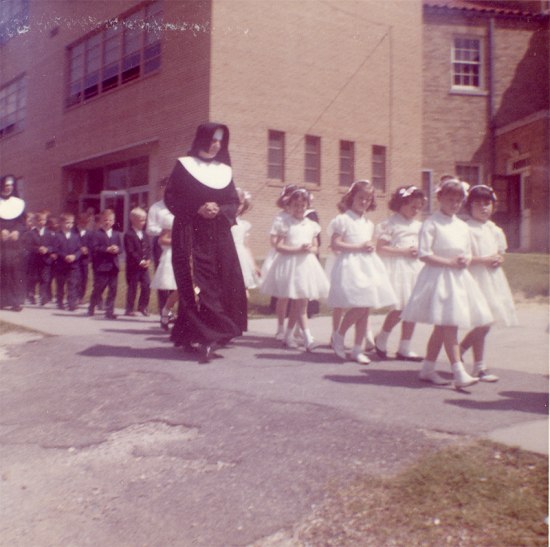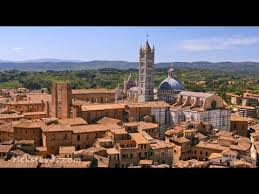During the 19th century, Catholics found themselves settled and growing in numbers in the United States, a great Protestant country that was relatively tolerant and hospitable toward Catholics. This, even though the American people generally felt that the Roman religion adhered to by these Catholics was a false and corrupt version of Christianity.
The leaders of the Catholic Church in America – its bishops, priests, and religious sisters – were well aware of the great danger that Catholics, an island surrounded by a vast sea of Protestantism, might fall away from the true faith and either: (a) embrace the Protestant heresy; or (b) become mere infidels, having no religious belief at all.
And so the leaders of the Church, aided and abetted by myriads of devoted laypersons, developed a vast network of religious institutions designed to keep Catholics and their children and grandchildren within the faith.
The most important of these institutions were dioceses, parishes, schools, colleges, seminaries, and hospitals. But they also included Catholic newspapers, magazines, and book publishers; the Knights of Columbus and the CYO; and dozens of other things. Above all, they included strong barriers to intermarriage between Catholics and outsiders. Catholics built a quasi-ghetto for themselves, a kind of imperium in imperio.
And for a long time it worked. Although there were defections from the faith, they were relatively few and far between, especially when we consider the many opportunities available in a country that was growing steadily more tolerant of Catholics and their religion.
All this collapsed beginning in the 1960s. The walls of the “ghetto” fell down like the walls of Jericho, cracked and undermined by the loudly blaring trumpets of post-modernity. This was partly due to Vatican II; it was much more due to “the spirit of Vatican II.”
Most of all, however, it was due to the fact that Catholics were entering fully into the mainstream of American life at precisely the moment – the fatal moment – when the United States was ceasing to be a Protestant country and was becoming instead a country dominated by the culture of secular humanism.
In the first half of the 20th century the traditional Protestant mind of America had been replaced by a liberal Protestant mind, and, in the second half, the liberal Protestant mind was being replaced by an agnostic mind.
As long as the walls of the ghetto were standing, Catholics were not strongly tempted to abandon Catholic convictions and embrace Protestant convictions. For instance, no matter how poor an opinion Protestants had of the Catholic “worship” of the Virgin Mary, Catholics kept up their Marian devotions. If anything, they intensified these devotions, as if to say, “Take that, you Mary-phobic Protestants!”
Another instance: the practice of divorce and remarriage. Although this had always been approved of (at least in certain circumstances) among Protestants, and although it was becoming more and more common in America, and although Hollywood celebrities often carried it to ridiculous extremes, Catholics generally speaking continued to adhere to the old teaching that marriage is indissoluble.

As long as the walls of the ghetto remained standing, the Catholic bishops of America could say to the outside world, “You Protestants can do whatever you like, but you won’t draw our Catholic men and women into the error of your ways. Our bet is that they will remain steadfastly Catholic, a bet we feel confident that we’ll win.”
Once the ghetto walls collapsed in the ‘60s and ‘70s, however, all bets were off. Catholics, above all Catholics of the younger generations, began swimming with the current of popular opinion.
But this time the current was not a Protestant current; the demand was no longer that we stop “worshipping” the Virgin or that we remarry after our first marriage falls apart. No, the current was now a highly secularized current, even an anti-Christian current, and it demanded:
· that we fornicate, preferably with multiple partners;
· that we have abortions, or at least express our support for those who do;
· that we give in to our homosexual temptations (if we happen to have any) and, after we have done so, boast of being “true” to ourselves;
· that we deplore or ridicule those who decline to swim with the current;
· that we not waste our valuable time attending Mass on a weekly basis; and that, if we do choose to waste our time in that manner, we at least reject the old superstition that Jesus Christ is really and truly present in the Eucharist.
In America, I cannot help but conclude, the Catholic religion without the protection of ghetto walls is a thing that won’t work. It’s a lost cause, a religion that will slowly but surely fade away.
What then? Am I suggesting that we rebuild the old ghetto? No, that’s impossible. It’s gone forever. The clock of history never runs backwards.
History suggests that the Catholic religion can flourish in two circumstances only: (a) When it is the virtually universal religion of a society – as it was for many centuries in Spain, Portugal, Italy, and certain other places; and (b) When it is a ghetto religion surrounded and more or less persecuted by hostile forces – as it was under British rule in Ireland, or Communist rule in Poland, or pagan rule in ancient Rome.
American Catholics must face unpleasant facts: that we are surrounded by enemies of our religion; that these are not moderate enemies, like the old Protestants. No, they are red-hot enemies, atheistic or quasi-atheistic in mind and morals; that they dominate, or are rapidly coming to dominate, the command posts of American culture – colleges and universities, public schools, the entertainment industry, the journalistic mass media, and the Democratic Party.
If we’d like our religion to survive in the America, we have no choice, I submit, but to create a new ghetto, however difficult that may be to imagine at present. I don’t mean the Protestantism-resistant ghetto of old. I mean the creation of a new kind of ghetto, an atheism-resistant ghetto.
*Image: May Day Celebration, 1963, St. Francis Xavier Catholic School, Washington, D.C. [Smithsonian National Museum of American History, Washington, DC]
You may also enjoy:
George J. Marlin and Brad Miner: The Ad Hoc Moral Theology of Cardinal Dolan
Elizabeth A. Mitchell’s Waiting for God’s Best















